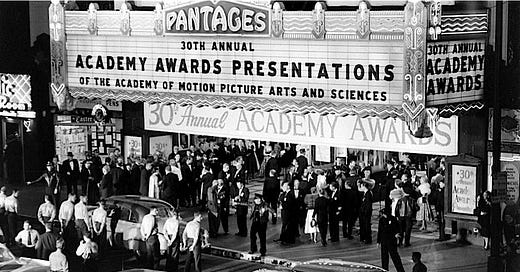Ranked Choice, the Oscars, and 2025 ratings
A quick followup; Plus a little bit about the Hulu stream problems
Just a quick note about Oscar voting. For Best Picture, the Oscars employs a “preferential ballot,” which is commonly known as ranked choice. Ranked choice ballots were initially used from 1934 to 1945, after which point then they went to "most votes wins.” That was until 2009. In 2009, The Academy shifted it back to a ranked choice approach but only for Best Picture. The change was installed due at least in part to outcry over a perceived snub. Christopher Nolan’s The Dark Knight was overlooked for Best Picture nomination. This was in spite of widespread commercial success and critical acclaim.
In 2009, they tried to address the matter by introducing a ranked choice process for nominations as well as the Best Picture decision. (It is possible ranked choice was used for nominations prior to this and for categories other than Best Picture, but I’m having trouble finding reputable sources on those details). 2009 was also the year the Academy expanded the number of nominations for Best Picture from 5 to 10. This change was reportedly made to increase recognition for a broader pool of films and to create a larger ratings draw for the telecast, by making it possible to have all types of films, including popular ones in the mix.
The expansion of the Best Picture category (or its equivalent, since the name has changed over time) was also not unprecedented. In the 1930s and 1940s, the category sometimes had up to 12 nominations. I know this because I once wondered about what happened in the year when both Gone with the Wind and The Wizard of Oz were up for recognition. The answer is, Gone with the Wind swept and Judy Garland got a special Junior Oscar for her role as Dorothy in the Wizard of Oz. 1939 also had Wuthering Heights (my favorite filmic version of it, anyway), and Of Mice and Men. Big film year!
Apparently by 1945, the Best Picture category got capped at 5 nominees and it remained as such for decades, until 2009. You can read more about the preferential ballot process here.
The ratings figures are in and the 2025 telecast saw a dip from the year prior, with 18 million viewers. The figure compiled both linear television viewers that watched on ABC’s broadcast and the streamers that watched on Hulu. I’m a linear tv gal but heard that the Hulu stream was set to conclude at the end of the planned timeframe, in spite of the fact that the Oscars is a notoriously long show that regularly exceeds its planned timeframe. This cut viewers off right before high profile awards were presented for Best Actress and for Best Picture. It strikes me that the lesson here is to stick with linear television.
As a media historian, I also value that broadcast networks must partner with local television network affiliates. The streaming business is harming local television affiliates in a way that can be compared (though perhaps less immediately and dramatically) to the rise of digital news hurt the print news business. So keeping up those ties to linear tv is worthwhile if you are a supporter of broadcast and local media. For this reason, there is no scenario in which I would chose to stream a program if I had a more stable viewing option via broadcast or cable.




